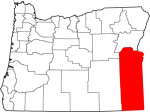|
Welcome to Malheur County ORGenWeb
History
|
History
of Malheur County, Oregon
This proposition they accepted, reorganized the company increasing the capital stock to $100,000 In 10,000 shares of the par value of $10 each, a large amount of the new stock was subscribed for, several contracts were let to be paid for in notes and stocks, and work began it earnest. In the spring of 1890 the ditch was completed, then bonded for $50,000 and its debt paid off. The Owyhee ditch is probably the largest one in Oregon. It Is 20 miles long, for the first ten miles is 20 feet wide on the bottom, gradually tapering front that to all 8-foot ditch, where it drops into the Malheur river, and will water 20,000 acres of land. The company has first right to 28,000 inches of the waters of the Owyhee River and their property is worth at a low estimate half a mullion of dollars. Since the completion of this ditch there has been a great transformation in the appearance of the valley. Sagebrush plain that for ages has been only the home of the coyote and jackrabbit, is being rapidly turned into farms which are producing grasses, vegetables and grains of an infinite variety and in marvelous abundance. Settlement in the Malheur valley now extends up for 30 miles front its mouth. Above the Nevada ditch are the Sand Hollow ditch, the Gillerman & Froman ditch, the Malheur Farmers' ditch and a number of other private ditches which furnish water for a large number of farmers who are beautifying, the valley and enriching themselves. Aldel Creek, a tributary of the Malheur, furnishes considerable water, and in this valley are located a number of families who are prosperous and happy. Wastefall is their post office and trading point. Jordan creek, a tributary of the Owyhee, located towards the southern part of the county and about 50 miles from the railroad, also flows considerable water. The valley is settled by a class of enterprising farmers and stock raisers with Jordan Valley as their post office and trading point. Beulah, on the Malheur River, in the extreme western part of the county, is the post office of a number of families who are engaged in raising stock. In fact wherever there is found a tract of valley land that can be watered without too great expense, on it may be found one or more happy families. To the casual reader it may appear that the word "happy" is used herein rather indiscriminately, but not so. The farmer in the East plants his crops, then prays for it to rain, or growls for it to quit. We plant our crops and when we want it wet, go and raise the gate and so it is done. When we want the water to cease, we close the gate. For this advantage over nature we feel occasion for pardonable felicitation. A few orchards have been planted in the county long enough to come into bearing, and the result demonstrates that this is the home of the apple, prune, peach, pear, plum and cherry, and all varieties of berries known to the northern temperate zone. Hundreds of acres are now being planted to trees and raising fruit will soon be our leading industry. Owing to great expanse of hills covered with luscious bunchgrass, stock raising has been and will continue to be a source of great wealth to our citizens. In the main the county is void of timber, but the ever present sagebrush is here and furnishes an abundance of fuel. Coal has been found in three different places in the county, but not in sufficient quantity to pay to work. With the exception of the small tracts of placer ground in Mormon Basin and Malheur City that have been worked out, the mineral resources of the county are yet undeveloped. Gold bearing quartz ledges of considerable strength have been found near Malheur City, and on Iron Side Mountain, but the ore is base and of low grade, and no machinery has yet been put on them. The gravel bars and sands of Snake River abound in flour gold so fine that a thousand colors will hardly make one cent, and so buoyant that it is difficult to save. These bars have been worked with more or less success for a number of years. Thousands of dollars have been expended on machinery for saving it on a large scale, which unfortunately have proven a losing experiment. We are informed that a process has recently been discovered which will save 90 per cent of it, and three large outfits representing a cost of over sixty thousand dollars have recently been unloaded at Ontario, and will soon be at work on the river saving the gold by the new treatment. Whether they save it or not there is no necessity for an able-bodied man being broke here. With a rocker, a shovel and a dipper, he can go down to the river almost any place and take out 75 cents to $1.50 in dust per day. This is a fact which the writer has seen demonstrated many times during the last fourteen years. Vale, the county seat of this county, is pleasantly situated on the banks of the Malheur river, 16 miles above its junction with Snake, and that distance off the railroad. It has two bright weekly newspapers. Here the county has a commodious court room, clerks' and sheriff's offices and steel cage jail. The buildings are inexpensive wooden structures, but answer every purpose. All the leading branches of the mercantile business are represented in Vale, and it has a class of enterprising citizens. Mindful of the education of their children a neat four-room schoolhouse ornaments one of its blocks. It has two commodious hotels under able management, two large livery and feed stables, two substantial store buildings that would ornament a city of much greater pretensions, a number of substantial framed store buildings which are filled with complete stocks of goods represented in their respective lines; Odd Fellows hall, a public hall in the second story of one of the stone store buildings, equipped with stage and scenery, and a number of beautiful private residences. Here, just across the river and at the edge of the city limits, is found the artesian well, which, in exhausts like an engine, throws a two-inch stream of boiling water 30 feet high and they are making arrangements to pipe it into the city to be used for heating and domestic purposes. This water was struck at a depth of less than 45 feet. Having the interests of the people at heart and rather anticipating future needs, some of the leading citizens of Vale and vicinity have formed a company and there erected a substantial stone and framed flouring mill operated by water front the Malheur river, and equipped it with the modern roller process machinery. It is now in operation with a capacity of 50 barrels per day. The building and power is ample for machinery of 100 barrels per day, and the increase in capacity will be made, as occasion requires. Vale has the trade of a large tract of country, and a long period of prosperity and usefulness before it. The county has been particularly fortunate in the selection of officers who have managed its finances with great prudence and wisdom, and the strong iron bridges which span the rivers at convenient distances are monuments of their good judgment. Nyssa, the first station reached on the O. S. L. R. R. on entering the state is eleven miles east of Ontario, and the post office and trading point of a bright little settlement. Ontario, the only telegraph and regular reporting railroad station in the county, is located on the O. S. L. R. R. near the eastern boundary, and is the metropolis of the county. All branches of business are here represented. It has two hotels, which are well managed. The hotel Ontario is a palatial 30 room building of modern and beautiful design, and is an ornament to the city. The Methodist and Congregational societies each have a neat church edifice in which religious services are regularly conducted and largely attended. It has four commodious brick store rooms, with lodge hall over one of them, several large framed store buildings, four immense warehouses on railroad side track, large lumber yards, many fine residences, and a beautiful four roomed brick school house in which is conducted a graded school under the management of able teachers. Ontario is proud of its school. The principal streets are graded and set with shade trees on both sides. Water from the large irrigation ditches flows constantly down either side of the streets and on private grounds when desired. Ontario is the regular railway shipping point for not only Malheur County but all southeastern Oregon, and has the trade of all this territory. Here are found the largest stocks of goods on the O. S. L. R. R. Millions of pounds of freight are annually received at this station. Some idea of the magnitude of freight shipments may be gained when it is known that in 1866, 673 cars of livestock and two train loads of wool were shipped from this station. This business continued with little variation until 1896, when the stock shipments alone were 1034 carloads, and in 1897 the shipments ran all to 1982 cars of live stock alone, of which 652 carloads were sheep and the balance principally cattle. The railroad station agent has kindly furnished these figures and they are substantially correct. Experiments have proven that a sugar beet carrying a very high percentage of saccharine matter can be produced here, and negotiations for the establishment of a beet sugar factory at Ontario are already under way. A starch factory is also one of the near probabilities. The county is peopled by a distinctively American class and out of a population of about 6000 not fifty foreigners can be found. What foreigners there are are thoroughly Americanized and good citizens. All the desirable valley lands have been located, but wild land with water right can be bought from $15 to $25 per acre, according to distance from railroad. The lord has blessed the locality with a soil of great fertility, and over it has hung an Italian climate. Immigration of it thrifty and industrious people is most earnestly desired and all look forward to a period of great prosperity and progress. |
©
ORGenWeb All Rights
Reserved.
This page last updated:


